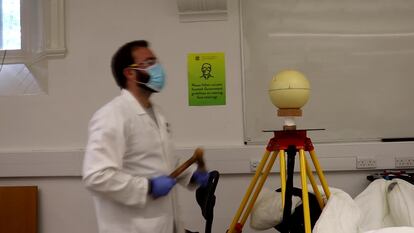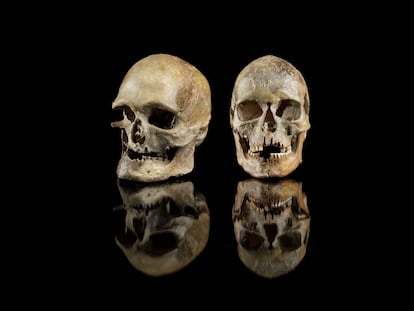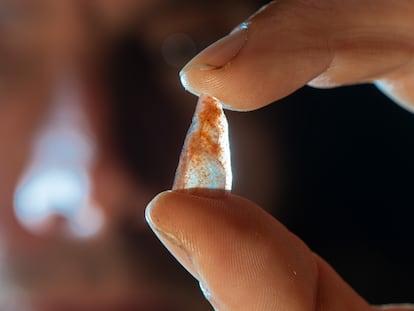A fatal axe blow to the skull casts light on the violent brawls of the Neolithic
Pierced remains of a prehistoric human head provide clues about the violence of the past, as paleoanthropologists experiment by smashing fake craniums in the lab
A stone weapon violently impacts a skull, causing a mortal wound. A scientist has inflicted this surprise blow, an attack that sometimes comes from the front, but also, treacherously, from behind, piercing the victim’s head and causing their death. The lab simulation is replicated until the researcher is able to tell exactly how it happened during the Neolithic. He repeats the action over and over again, trial and error, until he comes up with the model that best resembles the actual cranial impact that took place in the depths of a cave thousands of years ago.
This unprecedented recreation was carried out by paleoanthropologist Miguel Ángel Moreno-Ibáñez from the Catalan Institute of Human Paleoecology and Social Evolution (IPHES), in Spain. The scientist designed head models made of polyurethane and silicone and then smashed them with axes and adzes (a cross between a Neolithic hatchet and a hammer). The fake skulls simulate the thickness of the human skeleton and the subcutaneous layer of the skin, and are filled with ballistic gelatin, which is similar in viscosity to the soft tissue of the brain. The goal of this exercise in violence was to find out everything about the actual prehistoric assault, how the attacker acted and what the skeletal remains of the murdered victim reveal. “The direction of the blow, the type of fracture, the indentation of the skull, the position of the fissures and where they are directed,” details the lead researcher. Their work has now been published in the Journal of Archaeological Science.
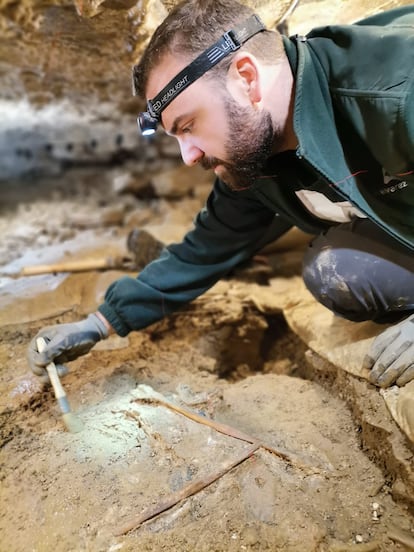
Approximately 5,000 years ago, in a cave in northeast Spain, someone snuck up on an elderly man from behind and struck him over the head with a blunt object, probably killing him. It was an encounter between two individuals that left clues in the Catalan archaeological site of Cova Foradada in Calafell, Tarragona.
“This is an episode of interpersonal violence, if we get technical,” laughs Moreno-Ibáñez. The researcher cannot say whether this was an isolated case, a feud within a local group or a brawl against a rival clan, because the victim was part of a collective burial with at least 18 other people.
“Our methodology comes from forensic science and ballistics; Same method, but applied to prehistoric archaeologyMiguel Ángel Moreno-Ibáñez, paleoanthropologist
The main objective of this reconstruction was to find out whether the injury was intentional or accidental, because a death after a fortuitous event was a common occurrence during the Neolithic. “Our methodology comes from forensic science and ballistics; they are widely used resources to examine the entry and exit of a bullet,” explains Moreno-Ibáñez. “Same method, but applied to prehistoric archaeology.”
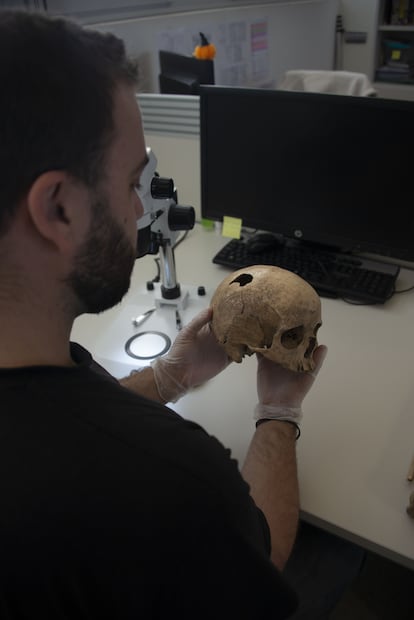
The researchers chose the two most common weapons from the time, a stone axe and an adze – two tools that were also useful to injure an enemy – because the object that was used in the assault left the mark of a straight surface on the bone of the victim, which led them to rule out other options.
Moreno-Ibáñez points out that in Late Neolithic Europe, “violent confrontations [began], although not on a large scale or in a widespread manner.” Despite this, these encounters did not always mean certain death for the participants; there is “evidence of healed wounds and even very archaic proto-surgery and medical care,” says the author.
Ironically, this was due to an increase in the general quality of life, a greater production of food, livestock and agriculture, with the important growth in population this entails. This “inevitably causes clashes and rivalries” between different groups, continues the scientist, who is also a lecturer at the Rovira i Virgili University. However, “you shouldn’t think that they were at war all day.”
Regarding the dead man that was found in the Tarragona cave, the researcher considers it to be an isolated case of violence that “got out of hand.” The scientists found the victim buried with “funeral treatment” in the archaeological site, “just like the other corpses found; there is no difference.”
Sign up for our weekly newsletter to get more English-language news coverage from EL PAÍS USA Edition
Tu suscripción se está usando en otro dispositivo
¿Quieres añadir otro usuario a tu suscripción?
Si continúas leyendo en este dispositivo, no se podrá leer en el otro.
FlechaTu suscripción se está usando en otro dispositivo y solo puedes acceder a EL PAÍS desde un dispositivo a la vez.
Si quieres compartir tu cuenta, cambia tu suscripción a la modalidad Premium, así podrás añadir otro usuario. Cada uno accederá con su propia cuenta de email, lo que os permitirá personalizar vuestra experiencia en EL PAÍS.
¿Tienes una suscripción de empresa? Accede aquí para contratar más cuentas.
En el caso de no saber quién está usando tu cuenta, te recomendamos cambiar tu contraseña aquí.
Si decides continuar compartiendo tu cuenta, este mensaje se mostrará en tu dispositivo y en el de la otra persona que está usando tu cuenta de forma indefinida, afectando a tu experiencia de lectura. Puedes consultar aquí los términos y condiciones de la suscripción digital.
More information
Últimas noticias
NASA discovers Titan doesn’t have an ocean, but a ‘slushy ice layer’ that increases possibility of life
Innocence lost in the forest of the child soldiers: ‘Each leader of the armed group had his girls’
‘Fallout’ or how the world’s largest company turned an anti-capitalist apocalyptic Western into a phenomenon
From inflation to defending migrants: Eileen Higgins and Zohran Mamdani inaugurate the new Democratic resistance against Trump
Most viewed
- Christian Louboutin: ‘Young people don’t want to be like their parents. And if their parents wear sneakers, they’re going to look for something else’
- ‘El Limones’ and the growing union disguise of Mexican organized crime
- The low-cost creative revolution: How technology is making art accessible to everyone
- ‘We are dying’: Cuba sinks into a health crisis amid medicine shortages and misdiagnosis
- Liset Menéndez de la Prida, neuroscientist: ‘It’s not normal to constantly seek pleasure; it’s important to be bored, to be calm’
